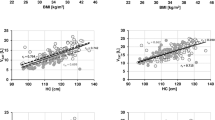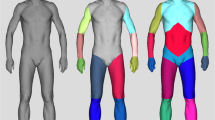Abstract
OBJECTIVE: To evaluate the relationships between the supine sagittal abdominal diameter (SAD) and visceral fat, as well as to evaluate intra- and inter-observer reliability of sagittal diameter measurement.
PATIENTS: Twenty-eight women ranging in age from 27–78 y with a body mass index (BMI) ranging from 16.9–48.1 kg/m2 and 23 men ranging in age from 32–75 y with BMI ranging from 20–41.6 kg/m2.
MEASUREMENT: Body fat distribution was measured by waist circumference, waist to hip ratio (WHR), SAD, anthropometrically assessed and a single slice of computed tomography (CT) at the L4-L5 level.
RESULTS: In both genders, a significant association was found between visceral adipose tissue (AT) and SAD, as evaluated by CT (women r=0.80; men r=0.83, P<0.001), and SAD by anthropometry (women r=0.76; men r=0.82, P<0.001), as well as between visceral AT and waist circumference (women r=0.76, men r=0.86, P<0.001) and WHR (women r=0.57, P<0.01, men r=0.80, P<0.001). A significant association was also found between subcutaneous AT and SAD by anthropometry (women r=0.79, men r=0.74, P<0.001). After adjusting for BMI, the association between subcutaneous AT and SAD was no longer significant in men and only moderately significant in women (r=0.42, P<0.05), while the association between visceral AT and SAD by anthropometry remained significant in both genders (women r=0.63, P<0.001; men r=0.66, P<0.001). When the subjects were divided into two groups according to BMI (lean to moderately overweight women with BMI<28 and men with BMI<30 and obese women with BMI>28 and men with BMI >30) we found that the relationships between SAD by anthropometry, as well as SAD by CT and visceral AT, were higher in lean to moderately overweight subjects than in those who were obese. High inter-observer correlation was found concerning SAD measurement (r=0.99, P<0.001). Intra- and inter-observer precision as evaluated by coefficient of variation and intraclass correlation coefficient for SAD measurement was very high.
CONCLUSION: Our study shows the usefulness of SAD by anthropometry to predict visceral fat and its very high inter- and intra-observer precision.
This is a preview of subscription content, access via your institution
Access options
Subscribe to this journal
Receive 12 print issues and online access
$259.00 per year
only $21.58 per issue
Buy this article
- Purchase on Springer Link
- Instant access to full article PDF
Prices may be subject to local taxes which are calculated during checkout
Similar content being viewed by others
Author information
Authors and Affiliations
Rights and permissions
About this article
Cite this article
Zamboni, M., Turcato, E., Armellini, F. et al. Sagittal abdominal diameter as a practical predictor of visceral fat. Int J Obes 22, 655–660 (1998). https://doi.org/10.1038/sj.ijo.0800643
Received:
Revised:
Accepted:
Published:
Issue Date:
DOI: https://doi.org/10.1038/sj.ijo.0800643
Keywords
This article is cited by
-
Evaluation of the relationship between abdominal fat distribution and osteoporotic vertebral compression fracture with MRI
Skeletal Radiology (2023)
-
Associations between Central Obesity and Outcomes of Adult In-hospital Cardiac Arrest: A Retrospective Cohort Study
Scientific Reports (2020)
-
Visceral obesity is associated with white matter hyperintensity and lacunar infarct
International Journal of Obesity (2017)
-
Lifestyle INtervention for Diabetes prevention After pregnancy (LINDA-Brasil): study protocol for a multicenter randomized controlled trial
BMC Pregnancy and Childbirth (2016)
-
Anatomical and CT approach of the adipose tissue: application in morbid obesity
Surgical and Radiologic Anatomy (2015)



